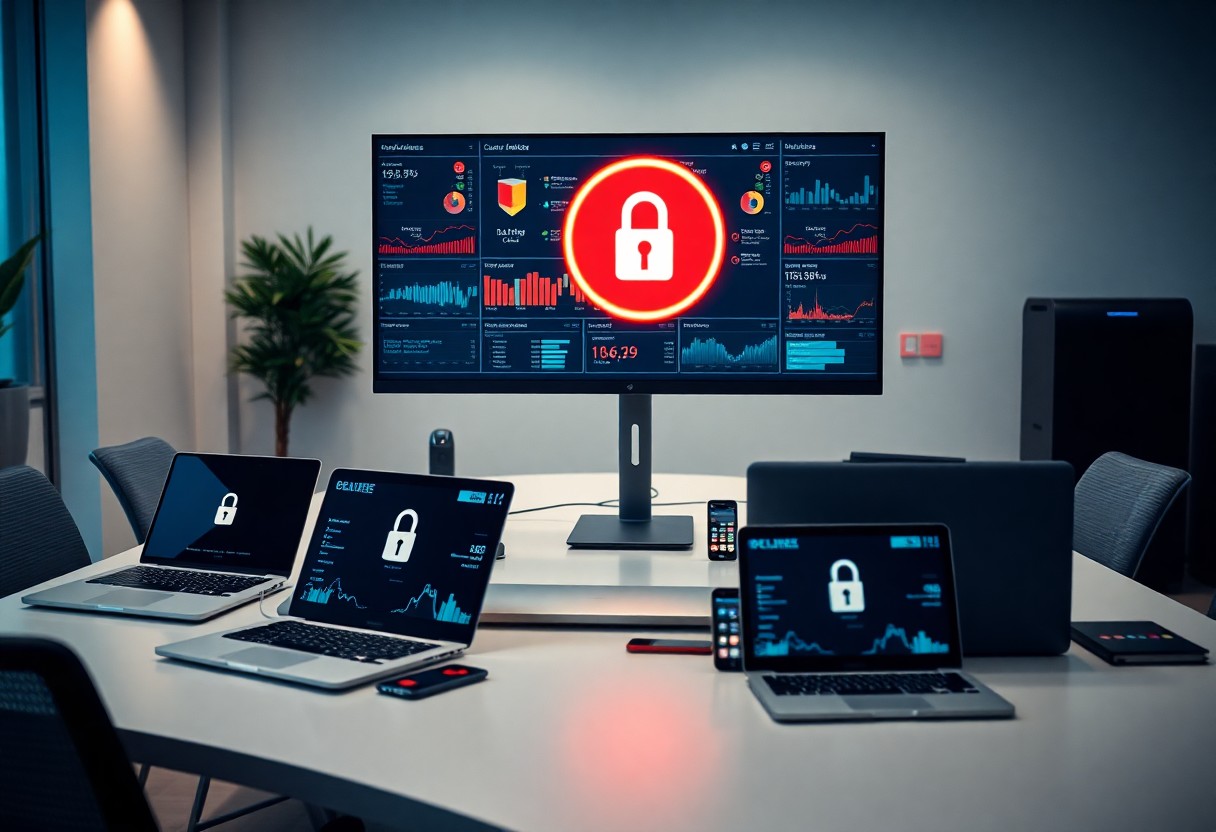What Is Endpoint Protection And Why It’s Critical For Cyber Security
You need to understand that endpoint protection is a vital component of your cyber security strategy. This technology...

There’s a growing need for robust endpoint protection in today’s digital landscape as cyber threats evolve and become more sophisticated. You must understand that your organization’s security depends on safeguarding every device connected to your network. By implementing effective endpoint protection, you enhance your resilience against potential breaches, data loss, and operational disruptions. This post outlines the key reasons why investing in endpoint security is crucial for maintaining the integrity and safety of your organization’s digital assets.

Endpoint protection encompasses a range of security solutions designed to protect endpoints, such as computers, mobile devices, and servers, from various cyber threats. By utilizing advanced technologies like antivirus, anti-malware, and intrusion detection systems, you can effectively secure your organization’s devices, ensuring that sensitive data remains safe from unwarranted access and breaches.
Endpoint protection refers to the security measures specifically implemented to defend endpoints—devices connecting to your network—from malicious activities, unauthorized access, and cyber threats. This includes software solutions that monitor, detect, and respond to potential risks, safeguarding the integrity of your organizational data.
Endpoint protection plays a pivotal role in your overall cyber security strategy, as endpoints are often the primary targets for cyberattacks. With an increasing number of devices connecting to business networks, you face heightened risks of data breaches and ransomware attacks. A solid endpoint protection strategy can mitigate these risks and bolster your organization’s security posture.
The significance of endpoint protection is underscored by statistics indicating that over 70% of successful cyberattacks stem from endpoint vulnerabilities. By investing in robust endpoint solutions, you not only enhance risk management but also ensure compliance with industry regulations. This not only protects your assets but also reinforces customer trust, as clients feel more secure knowing their information is safeguarded against potential threats.

The threat landscape continues to evolve, presenting increasing challenges for organizations. Attackers leverage sophisticated tactics, including phishing, ransomware, and advanced persistent threats (APTs), to breach defenses. With the digital environment expanding rapidly, your organization must adapt to these threats, deploying comprehensive endpoint protection to mitigate risks. The growing complexity of cyber threats necessitates a proactive strategy to safeguard your assets and maintain operational integrity.
Phishing schemes, malware, and ransomware are among the most prevalent cyber threats that you face today. Attackers often use social engineering tactics to trick users into divulging sensitive information or unwittingly executing malicious software. The increase of IoT devices further complicates security, as these endpoints can serve as entry points for attackers. Ensuring awareness and implementing robust protection measures are vital to countering these risks effectively.
The financial impact of data breaches is skyrocketing, putting immense pressure on organizations. According to a recent IBM report, the average cost of a data breach in 2023 reached $4.45 million, a staggering increase in recent years. Hidden costs, such as regulatory fines, legal fees, and reputational damage, can exacerbate the impact on your bottom line, making it imperative to prioritize endpoint protection to safeguard against potential breaches.
The rising costs associated with data breaches extend beyond immediate financial losses. For example, organizations may face increased premiums for cyber insurance, strained relationships with customers, and harm to brand reputation. Studies indicate that 83% of organizations experienced a breach that negatively affected their reputation. Engaging in proactive cybersecurity measures can mitigate these financial strains, ensuring you maintain client trust and safeguard your financial health in a perilous cyber landscape.
Investing in endpoint protection not only fortifies your organization’s defenses but also enhances overall operational efficiency. By employing advanced threat detection, you gain the ability to identify and neutralize threats before they escalate. This proactive approach minimizes downtime, safeguards critical data, and ultimately strengthens your organization’s resilience against cyber incidents.
Implementing robust endpoint protection provides multilayered security that goes beyond traditional virus defenses. With features like real-time monitoring, behavioral analysis, and automated response protocols, you can swiftly address potential threats and reduce vulnerability. Such a comprehensive strategy ensures that your endpoints remain secure from a wide array of cyber threats.
Endpoint protection plays a vital role in helping you meet industry compliance standards and regulatory requirements. Many sectors, including finance and healthcare, mandate strict data protection measures. Adhering to these regulations minimizes legal risks and avoids potential fines, while also reinforcing trust with clients and stakeholders.
Failure to comply with regulations like GDPR or HIPAA can result in substantial penalties and damage to your reputation. Effective endpoint protection aids in maintaining necessary audit trails, implementing data encryption, and ensuring user access controls are in place. Integrating these security measures not only keeps you aligned with compliance but also enhances your organization’s credibility and strengthens client relationships in an increasingly privacy-conscious landscape.
Selecting endpoint protection requires attention to several key features that enhance your cyber security posture. Key elements include:
Assume that these features collectively empower your organization to identify vulnerabilities and mitigate risks effectively. For more insights, check out What is Endpoint Protection? A Comprehensive Guide 101.
Rapid identification of threats is important for minimizing potential damage. Effective endpoint protection solutions utilize machine learning and behavior-based analytics to monitor activities continuously. This enables immediate detection of unusual patterns that could indicate a cyber attack.
Automated response functions significantly reduce the time it takes to address threats. When a threat is detected, the system can isolate affected endpoints, remove malicious files, and initiate remediation protocols without human intervention, thereby preventing further spread.
These automated capabilities not only respond to threats in real-time but also help standardize your incident response process. With the right tools, you can ensure consistent actions are taken, reducing the potential for human error. This instant reaction minimizes downtime, allowing your organization to maintain operations with minimal disruption. Investing in automated response features will empower you to have a resilient defense strategy against dynamic cyber threats.
Integrating endpoint protection with your existing systems enhances your cybersecurity posture while maintaining operational efficiency. This approach ensures that new solutions complement your current security infrastructure rather than disrupting it. Leveraging tools such as Endpoint Detection & Response: A Vital Component of your strategy allows for comprehensive coverage without redundant complexities.
Your endpoint protection needs to work in harmony with current security solutions to avoid gaps and overlaps. Compatibility ensures that tools such as firewalls, intrusion detection systems, and SIEM can effectively communicate and share data. This synergy provides a holistic defense mechanism, allowing for more accurate threat detection and an expedited incident response.
Implementing effective deployment strategies streamlines the introduction of endpoint protection into your environment. This involves planning the rollout carefully to minimize disruption and ensure effective integration with existing systems. Opt for phased implementation to facilitate testing and adjustments, allowing your team to address any technical challenges proactively.
Effective deployment strategies should account for diverse operating environments within your organization. By using pilot programs and focusing on high-risk areas first, you can identify potential issues without overwhelming your entire network. This targeted approach helps in training staff, refining processes, and ensuring that the endpoint protection integrates seamlessly with legacy systems, enhancing your overall cybersecurity resilience without hampering productivity.

Numerous organizations have demonstrated significant improvements in cybersecurity resilience through the implementation of endpoint protection. These case studies illustrate the tangible benefits and the necessity of robust cybersecurity measures in today’s digital landscape.
Organizations implementing endpoint protection have reported remarkable improvements in their cybersecurity resilience. For example, Company X fortified its defenses and experienced a 30% decrease in data breach incidents, demonstrating the effectiveness of proactive security measures. Similarly, Company Y enhanced its malware detection capabilities, resulting in a 60% lower infection rate compared to the previous year.
Insights gained from past cyber attacks shape future cybersecurity strategies and preparedness. By analyzing these cases, you recognize the critical importance of timely patching, employee training, and comprehensive threat assessments.
Understanding the lessons learned from cyber attacks reveals common vulnerabilities many organizations overlook. For instance, in the NotPetya ransomware attack, companies that failed to regularly update their software were more susceptible to breaches. Additionally, employee negligence remains a significant risk factor, underscoring the need for continuous training. Implementing multi-factor authentication and robust endpoint protection can mitigate many of these vulnerabilities and enhance your organization’s readiness against future threats.
To wrap up, implementing endpoint protection is vital for your organization’s cybersecurity resilience. It safeguards sensitive data, fortifies against evolving threats, and ensures regulatory compliance while minimizing downtime. By investing in robust endpoint security, you empower your employees to operate safely and enhance your overall security posture. Prioritizing this protection not only mitigates risks but also builds trust with clients and stakeholders. Make endpoint protection a cornerstone of your cybersecurity strategy to stay ahead in an increasingly digital landscape.
A: Endpoint protection is important because it provides a defense against various cyber threats targeting devices such as laptops, smartphones, and desktops. By monitoring and managing these endpoints, organizations can detect and respond to potential threats in real time, minimizing the risk of data breaches and ensuring the integrity of sensitive information.
A: Endpoint protection assists organizations in meeting regulatory compliance requirements by ensuring that sensitive data is secured and access is controlled. Solutions often include reporting features and audit trails that demonstrate compliance with regulations such as GDPR, HIPAA, and PCI-DSS, thus avoiding potential fines and penalties.
A: Endpoint protection enhances cybersecurity resilience by providing layered security measures that adapt to evolving threats. With features like automated updates, threat intelligence, and advanced analytics, organizations can proactively defend against attacks, recover quickly from incidents, and maintain operational continuity in the face of evolving cyber threats.
You need to understand that endpoint protection is a vital component of your cyber security strategy. This technology...
You rely on robust cybersecurity measures to protect your business from evolving threats, and Endpoint Detection and...